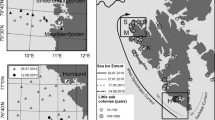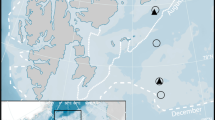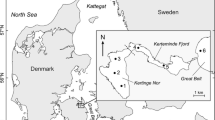Abstract.
Seasonal changes in feeding activity, metabolic rate and major tissue energy concentrations of the infaunal bivalve Laternula elliptica were monitored over a 12°month period in relation to phytoplankton standing stock. Chlorophyll a concentration displayed the prolonged winter minima and intense annual summer peak characteristic of polar environments. Divers made regular observations on the feeding activity of L. elliptica throughout the year, and siphons were completely withdrawn below the sediment surface at the start of the study in early September 1998. Siphons reappeared as chlorophyll concentrations rose at the end of September and these concentrations continued until late May 1999 when siphons were again withdrawn. There were, therefore, around 4 months in the austral winter when L. elliptica did not feed. Oxygen consumption rates were highly seasonal, varying from 4.3 µmol h–1 late in the winter (August 1999) to 12.9 µmol h–1 in summer (March 1999) for a 50°mm shell height individual, indicating a summer increase in oxygen consumption over winter levels of H×3.0. Nitrogen was excreted as 90% ammonium and 10% urea, and excretion rates were also highly seasonal. The O:N ratio did not vary significantly with size in winter (September, August), but declined with shell length in summer (November, January and March), indicating that larger bivalves used a higher proportion of protein to fuel metabolism than younger animals when feeding in summer. O:N ratios in August 1999 ranged from 3 to 16, indicating a predominantly protein-based metabolism. ANCOVA showed that regressions of dry tissue masses of major non-reproductive body components (musculature, ctenidia and digestive tissue) against shell height did not change between late winter and late summer. ANCOVA also showed that the regression slope for gonad mass against shell height was greater in late summer than late winter (slope F=7.37, P=0.009), and gonad mass was greater in all animals by late summer. Although tissue masses remained constant, energy content of non-reproductive tissues (especially musculature) declined from summer to winter. Muscle tissue also showed the greatest reduction in protein content, which was consistent with O:N estimates of primarily protein-based metabolism, especially in winter. Reduction in whole body energy content (5.84 kJ) agreed closely with total power utilisation during winter estimated from oxygen consumption (5.78 kJ). The data also showed that in contrast to temperate bivalve species, L. elliptica survives the prolonged polar winter with little reduction in body mass.
Similar content being viewed by others
Author information
Authors and Affiliations
Additional information
Electronic Publication
Rights and permissions
About this article
Cite this article
Brockington, S. The seasonal energetics of the Antarctic bivalve Laternula elliptica (King and Broderip) at Rothera Point, Adelaide Island. Polar Biol 24, 523–530 (2001). https://doi.org/10.1007/s003000100251
Accepted:
Issue Date:
DOI: https://doi.org/10.1007/s003000100251




